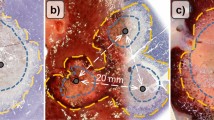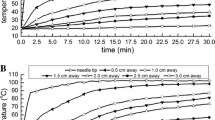Abstract
Purpose
To develop a flow model for bovine livers for extensive bench testing of technical improvements or procedure-related developments of radiofrequency ablation excluding animal experiments.
Methods
The perfusion of bovine livers directly from the slaughterhouse was simulated in a liver perfusion tank developed for the experimental work. The liver perfusion medium used was a Tyrode solution prepared in accordance with physiologic criteria (as for liver transplants) which was oxygenated by an oxygenator and heated to 36.5°C. Portal vein circulation was regulated via a flow- and pressure-controlled pump and arterial circulation using a dialysis machine. Flow rate and pressure were adjusted as for the physiology of a human liver converted to bovine liver conditions. The fluid discharged from the liver was returned into the perfusion system through the vena cava. Extendable precision swivel arms with the radiofrequency probe attached were mounted on the liver perfusion tank. RFA was conducted with the RF3000 generator and a 2 cm LeVeen needle (Boston Scientific, Ratingen, Germany) in a three-dimensional grid for precise localization of the generated thermolesions.
Results
Four bovine livers weighing 8.4 ± 0.4 kg each were prepared, connected to the perfusion system, and consecutively perfused for the experiments. Mean arterial flow was 569 ± 43 ml/min, arterial pressure 120 mmHg, portovenous flow 1440 ± 305 ml/min, and portal pressure 10 mmHg. Macroscopic evaluation after the experiments revealed no thrombi within the hepatic vessels. A total of 136 RF thermolesions were generated with an average number of 34 per liver. Mean RF duration was 2:59 ± 2:01 min:sec with an average baseline impedance of 28.2 ± 3.4 ohms. The mean diameter of the thermolesions along the puncture channel was 22.98 ± 4.34 mm and perpendicular to the channel was 23.27 ± 4.82 mm.
Conclusion
Extracorporeal perfusion of bovine livers with consecutive standardized RF ablation was feasible. The bovine liver flow model seems to allow extensive, standardized evaluation of technical or procedure-related developments of RF systems.



Similar content being viewed by others
References
Choti MA, Bulkley GB (1999) Management of hepatic metastases. Liver Transplant Surg 5:65–80
Friedman M, Mikityansky I, Kam A, Libutti SK, Walther MM, Neeman Z, Locklin JK, Wood BJ (2004) Radiofrequency ablation of cancer. Cardiovasc Intervent Radiol 27:427–434
Ott R, Wein A, Hohenberger W (2001) Liver metastases: Primary or multimodal therapy? Chirurgie 71:887–897
Rhim H, Dodd GD 3rd, Chintapalli KN, Wood BJ, Dupuy DE, Hvizda JL, Sewell PE, Goldberg SN (2004) Radiofrequency thermal ablation of abdominal tumors: Lessons learned from complications. Radiographics 24:41–52
Montgomery RS, Rahal A, Dodd GD 3rd, Leyendecker JR, Hubbard LG (2004) Radiofrequency ablation of hepatic tumors: Variability of lesion size using a single ablation device. AJR Am J Roentgenol 182:657–661
Schon MR, Kollmar O, Wolf S, Schrem H, Matthes M, Akkoc N, Schnoy NC, Neuhaus P (2001) Liver transplantation after organ preservation with normothermic extracorporeal perfusion. Ann Surg 233:114–123
Breedis C, Young G (1954) Blood supply of neoplasms of the liver. Am J Pathol 30:969–985
Thiel H (1977) Portacaval shunt therapy: An interdisciplinary task. Med Klin 72:1721–1729
Takala J (1996) Determinants of splanchnic blood flow. Br J Anaesth 77:50–58
Bergeron R, Kjaer M, Simonsen L, Bulow J, Skovgaard D, Howlett K, Galbo H (2001) Splanchnic blood flow and hepatic glucose production in exercising humans: Role of renin-angiotensin system. Am J Physiol Regul Integr Comp Physiol 281:R1854–R1861
Sase S, Monden M, Oka H, Dono K, Fukuta T, Shibata I (2002) Hepatic blood flow measurements with arterial and portal blood flow mapping in the human liver by means of xenon CT. J Comput Assist Tomogr 26:243–249
Braun U (1990) Ultrasonographic examination of the liver in cows. Am J Vet Res 51:1522–1526
Reynolds CK, Huntington GB (1988) Partition of portal-drained visceral net flux in beef steers: Blood flow and net flux of oxygen, glucose and nitrogenous compounds across stomach and post-stomach tissues. Br J Nutr 60:539–551
Huntington GB (1982) Portal blood flow and net absorption of ammonia-nitrogen, urea-nitrogen, and glucose in nonlactating Holstein cows. J Dairy Sci 65:1155–1162
Gellert K, David H, Otto G, Uerlings I, Wolff H (1985) Alteration of the ultrastructure of the pig liver after a continuous perfusion of six hours in vitro. Exp Pathol 28:245–250
Lencioni R, Cioni D, Crocetti L, Franchini C, Pina CD, Lera J, Bartolozzi C (2005) Early-stage hepatocellular carcinoma in patients with cirrhosis: Long-term results of percutaneous image-guided Radiofrequency Ablation. Radiology 234:961–967
Truebenbach J, Huppert PE, Pereira PL, Ruck P, Claussen CD (1997) Radiofrequency ablation of the liver in vitro: Increasing the efficacy by perfusion probes. Fortschr Roentgenstr 167:633–637
Rhim H, Goldberg SN, Dodd GD, III, Solbiati L, Lim HK, Tonolini M, Cho OK (2001) Essential techniques for successful radio-frequency thermal ablation of malignant hepatic tumors. Radiographics 21:S17–S39
Mahnken AH, Tacke J, Bucker A, Guenther RW (2002) Percutaneous radiofrequency ablation of liver malignancies: First experience with a 200-W radiofrequency generator. Fortschr Roentgenstr 174:216–223
Lu DS, Raman SS, Vodopich DJ, Wang M, Sayre J, Lassman C (2002) Effect of vessel size on creation of hepatic radiofrequency lesions in pigs: Assessment of the “heat sink” effect. AJR Am J Roentgenol 178:47–51
Acknowledgment
The study was conducted in the Department of Diagnostic Radiology, Ruprecht Karls University Heidelberg, Germany, and supported by the Porstmann Grant of the German Radiology Society
Author information
Authors and Affiliations
Corresponding author
Rights and permissions
About this article
Cite this article
Lubienski, A., Bitsch, R.G., Lubienski, K. et al. Radiofrequency Ablation (RFA): Development of a Flow Model for Bovine Livers for Extensive Bench Testing. Cardiovasc Intervent Radiol 29, 1068–1072 (2006). https://doi.org/10.1007/s00270-004-0338-4
Published:
Issue Date:
DOI: https://doi.org/10.1007/s00270-004-0338-4




